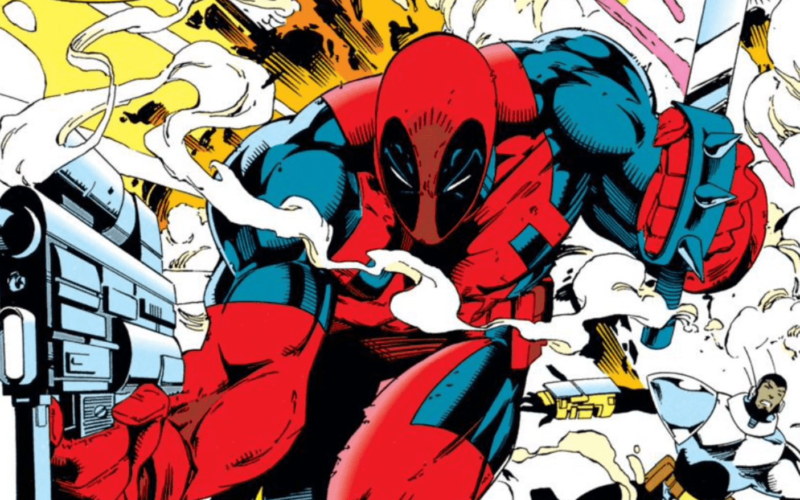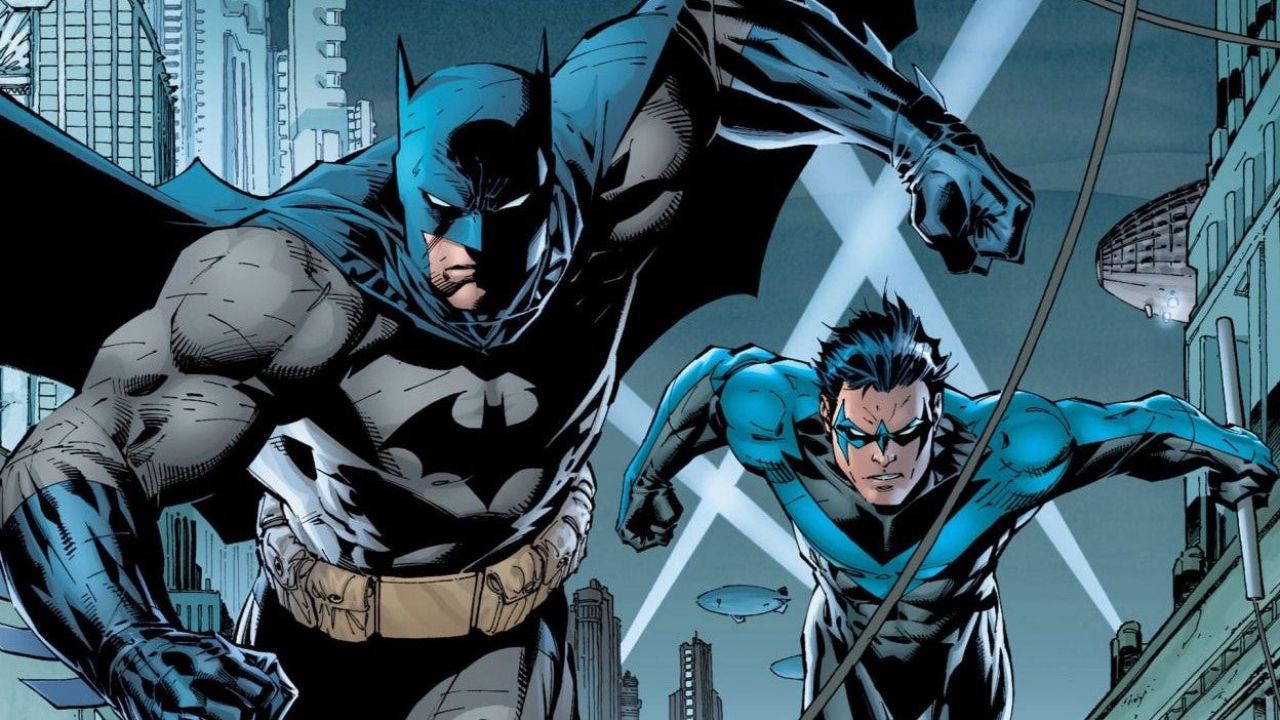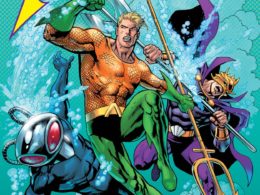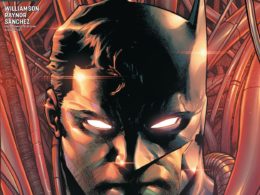What I’m about to tell you might sound crazy but Deadpool wasn’t always as popular as he is now; he wasn’t headlining three to five Marvel titles a month; thoughts of featuring him in an R-rated feature film were the furthest thing from a studio executive’s mind; he didn’t make chimichanga jokes or have his own video game or even break the fourth wall.
Like I said, a notion as crazy as the character who at one point in his history perpetually heard two (or should that be three?) different voices in his head. Of course, Deadpool didn’t always talk to himself or exhibit symptoms of schizophrenia either — and it’s because of this considerable character development that I find Deadpool to be such an engaging anti-hero. Which is why we’re going to take a trip down memory lane and explore the road to the Regeneratin’ Degenerate becoming a household name with these five noteworthy moments from Deadpool: Beginnings Omnibus.
Deadpool takes on Cable and the New Mutants in his first appearance
Issue: New Mutants #98 | Writer: Fabian Nicieza | Artist: Rob Liefeld
Why this made the cut:
Aspiring Deadpool completionist? New Mutants #98 is where it all began: the first appearance of the Merc with a Mouth.
Cable and Deadpool weren’t always strange bedfellows headlining their own comic book series. When Deadpool first came onto the scene he and Cable were bitter enemies; more specifically, Deadpool has been hired to kill Cable.
In this scene, Cable, the time-traveling, cybernetically enhanced super-soldier and newly established, militaristic leader of the New Mutants is (as all good leaders do) hanging out in the library, presumably reading up on ways to form a matryoshka doll of pouches on his pouch-covered fanny pack when all of a sudden:
BWOMPOOM. The ol’ “bomb in the book” trick. Or maybe Deadpool shot him by surprise? It’s hard to say exactly what happened with Liefeld’s art.
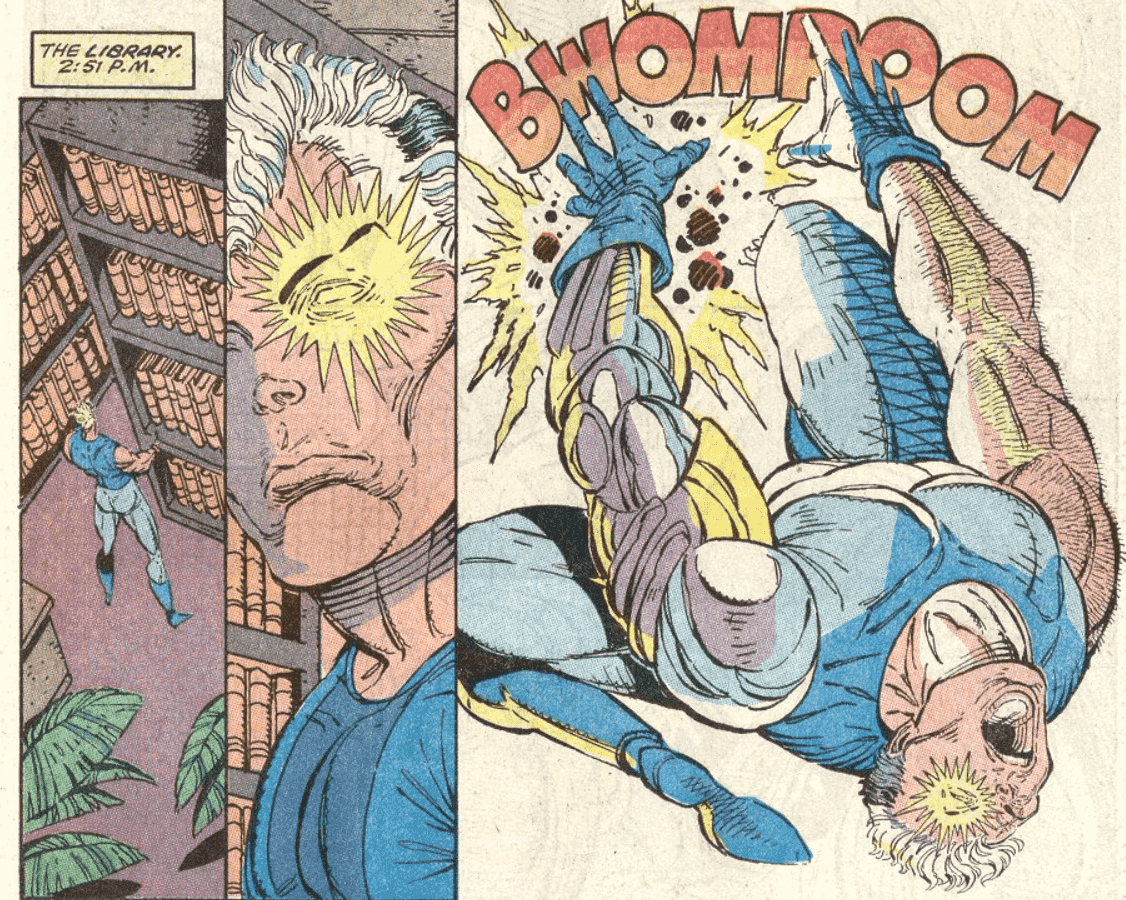

We soon learn Deadpool’s been hired by the enigmatic Mr. Tolliver to find and kill Cable. And just when it looks like he’s about to make good on that deal — the New Mutants interfere.
Notes of interest:
New Mutants #98 is very much a comic of its zeitgeist. Rob Liefeld’s art might take flak these days in retrospect but in the early ‘90s gaudy artwork often took precedence over complex narratives in comic books. Liefeld ushered in a rock star comic book epoch, his distinctive style turning New Mutants from one of the worst selling X-Men titles into a cash cow.
Cable’s New Mutants squad (this issue consisting of Boom-Boom, Cannonball, Rictor and Sunspot) would would transition into X-Force two issues later (and soon after that X-Force #1, a title Liefeld pretty much had full control over, would go on to sell four million copies on its debut, an industry record).
Differences in Deadpool:
Deadpool’s word bubbles in this issue aren’t outlined with their customary yellow — here, they’re magenta. As far as I know, Deadpool’s word bubbles have always been yellow (besides here). Does this mean his voice sounded different in this issue? Either something was lost in the translation with colorist S. Buccellatto, the word bubbles were transitioned to yellow trim after this issue or I’m looking into this way too much.
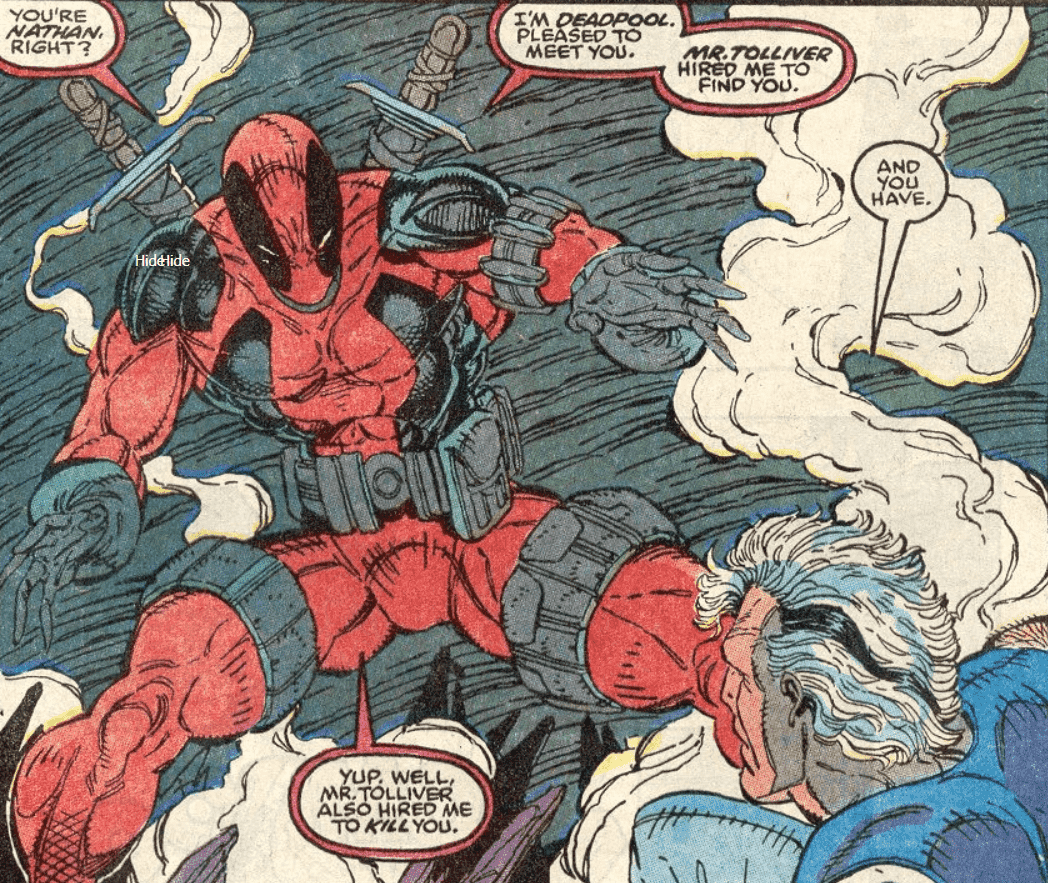

In this fight, Deadpool uses a neural disruptor net to ensnare Cannonball, a device which is able to bypass his blast field and incapacitate him from the fight. He also uses a similar ensnarement device to stranglehold Rictor. “Yeah — keep trying to shake them loose. The more energy you expend, the tighter they’ll constrict.”
Deadpool doesn’t frequently utilize neural disruptor nets as a weapon in his future jobs, so it’s unclear whether they were given to him specifically to take out Cable and the New Mutants or whether he stopped using them after he was no longer in Mr. Tolliver’s employ.
Favorite quote: “So when I frost your sorry, old mechanical butt, don’t take it personally, okay?”
Deadpool vs. Nomad
Issue: Nomad #4 (1993) | Writer: Fabian Nicieza | Artist: Pat Oliffe
Why this made the cut:
Witness one of Deadpool’s early mercenary jobs as well as scrap with a Super Soldier serum-enhanced former sidekick to Captain America.
What happens:
Nomad is an alternate identity which Steve Rogers, AKA Captain America took up in the 1970s when he became disillusioned with the American government. It’s also the alter-ego of Jack Monroe, a character who was also enhanced by the Super Soldier serum and served as Cap’s sidekick for a period of time. Eventually, Jack took on the name Nomad for himself in Captain America Vol. 1 #282 in 1988, donning a superhero costume and assisting Cap against the Constrictor.
In the 90s however (as most characters did in the 90s), Nomad went edgy — he went further on his own path as a long-haired, kevlar vest wearing, stun disk and sawed off shotgun-wielding vigilante and starred in his own ongoing series.
Being an expert marksman, possessing an enhanced physiology described as “at a slightly higher level than Captain America’s,” and having been trained in various fighting styles by Cap himself made Nomad a formidable combatant. Which is what makes Deadpool’s run in with him in Nomad #4 (1992) all the more impressive.
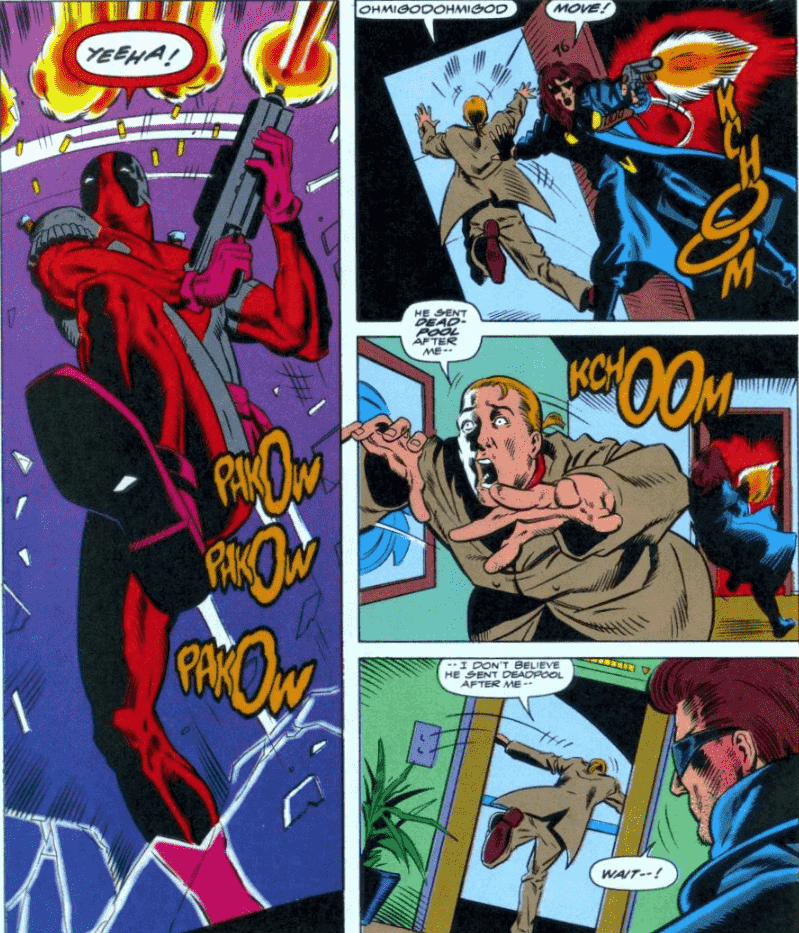

The issue is written by Fabian Nicieza, Deadpool’s co-creator, which means Deadpool is handled with a level of consistency from his previous appearances, even though he’s guest-starring in Nomad’s book. Deadpool is garrulous as always, but as Nicieza reveals — he’s also not a character to be taken lightly (something that is forgotten in the present where Deadpool is oftentimes relegated to a comedy relief meme machine role).
The story is part of the “Dead Man’s Hand” storyline, which ran through popular titles like Punisher and Daredevil and sees Nomad trying to protect a man named Troy Donahue from a number of mercenaries looking to off him; after successfully repelling attacks from Bushwhacker, a villain who can changes shapeshift his right hand into a cannon, Nomad crosses paths with Deadpool.
Donahue’s reaction to seeing that Deadpool has been hired to kill him is highly enjoyable — namely, he’s scared s—less. As he’s fleeing the hotel, he repeats loudly to himself, “He sent Deadpool after me. I don’t believe he sent Deadpool after me.” And then he closes the elevator door on Nomad (right after Nomad saved the guy for the umpteenth time) and leaves him to fend for himself against Deadpool.
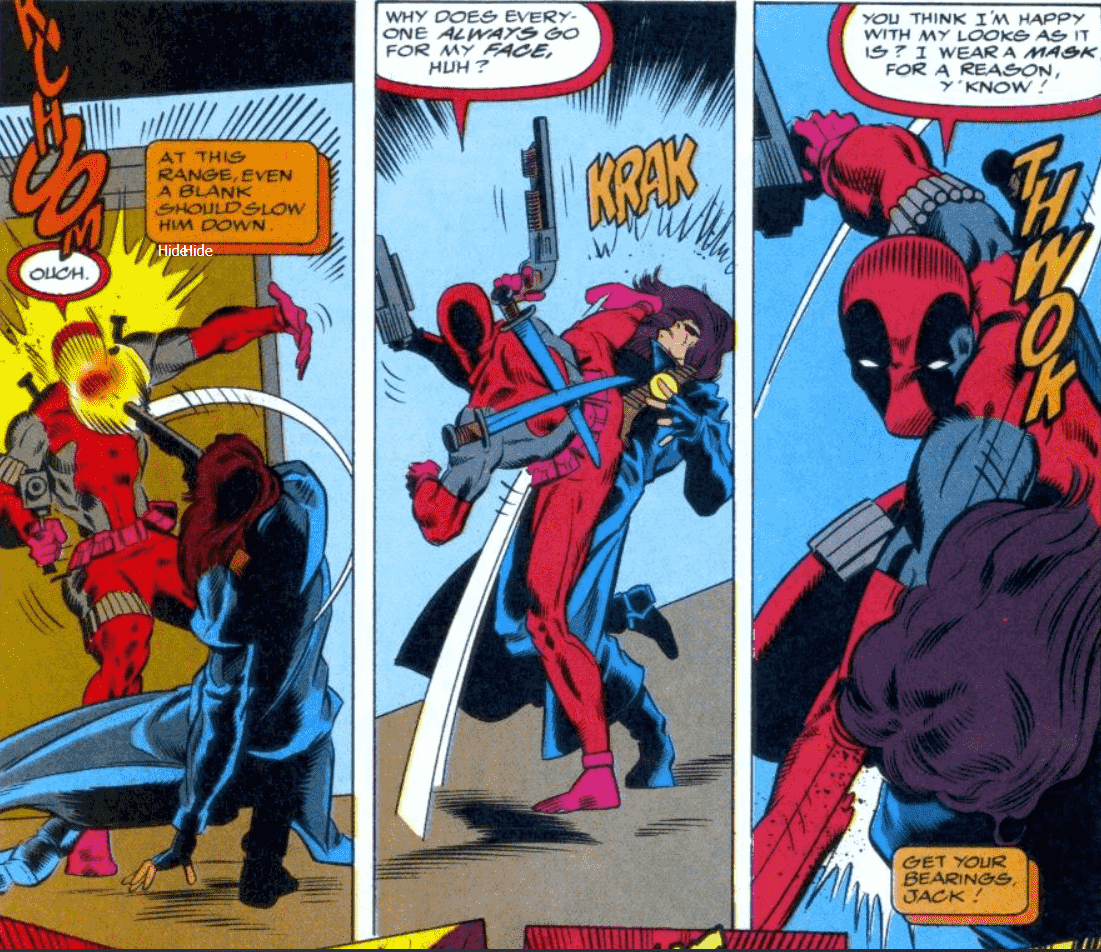

The fight between Deadpool and Nomad is brief, but dynamic and brutal. The two throw down in a hotel hallway, with Deadpool gaining the upper hand before Nomad is able to escape with a well-timed back roll into an elevator. Even then, he’s not in the clear, as Deadpool continues to stalk him with horror movie monster tenacity. (Deadpool rams his machete through the elevator doors, which prompts Nomad to respond with, “Give me a heart attack, why don’t you?”)
Notes of interest:
After the fight, when Nomad is recovering in his hotel room, he remarks on how “That Deadpool guy can hit like a mother.” Which is an interesting bit of continuity as years later, in Fabian Nicieza’s Cable and Deadpool run, Taskmaster says something similar during a fight with Deadpool: “Forgot how hard he hits.”
Also, during their scrape, Nomad both elbows Deadpool directly in the face and fires a blank into it. Deadpool remarks, “Why does everyone go for the face? I wear this mask for a reason you know.”
Differences in Deadpool:
This is the first hint towards Deadpool’s gruesome appearance under the mask, since at this point in the comics timeline we haven’t yet seen Deadpool’s real face. We’d first see it in Deadpool’s first mini-series, The Circle Chase, which was released a year after this issue of Nomad.
Which brings us to our next entry…
First appearance of Deadpool’s healing factor and “best friend”/arms supplier
Issue: Deadpool: The Circle Chase #1 | Writer: Fabian Nicieza | Artist: Joe Madureira
Why this made the cut:
Deadpool: The Circle Chase (1993) was Deadpool’s first solo outing, a mini-series written by Fabian Nicieza and drawn by Joe Madureira.
The Circle Chase was where a lot of the groundwork was set for the Deadpool character as we know him today: his incessant blathering; his turbulent relationship with Vanessa/Copycat; the harrowing experiments he underwent at Weapon X; and perhaps most interestingly, the first forthright mention of his healing factor (and the adverse effect it had on his physical appearance).
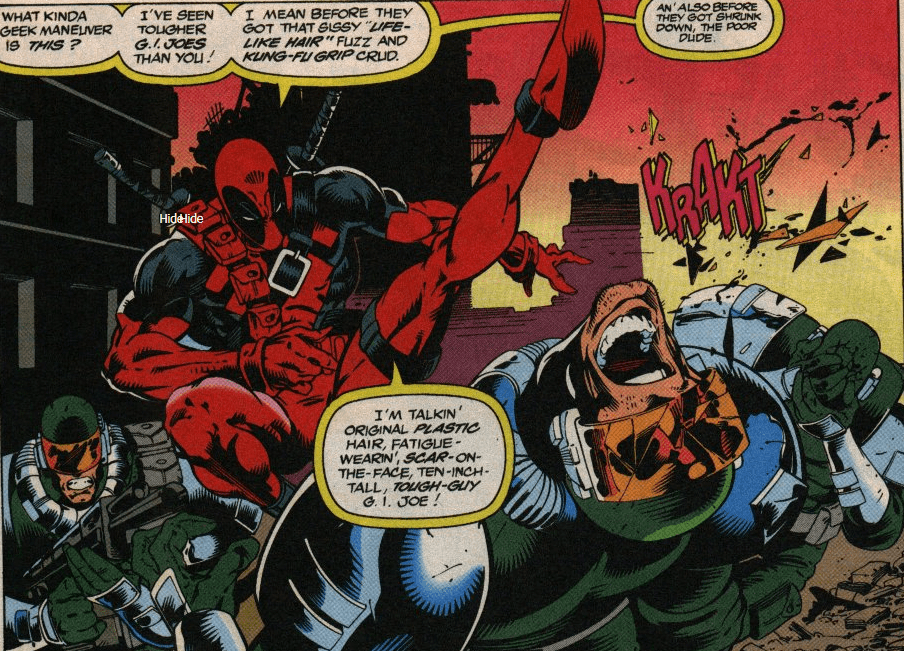

Also, Joe Madureira, with his blend of Arthur Adams and manga-influenced art, was one of the hottest up and coming artists of the 90s and The Circle Chase was one of his first projects at Marvel before he took over as the regular penciler of Uncanny X-Men in 1994. (His stylistic redesigns of the X-Men in 1995’s “Age of Apocalypse” crossover were a definite contributing factor to the storyline’s massive success.)
What happens?
After a slick fight-sequence that sees Deadpool dust a group of heavily armed super-soldiers in the war-torn setting of Sarajevo (the entire time rashing on them for looking like overgrown G.I. Joe/Ken doll hybrids), the Merc with a Mouth returns to his temporary hideout, where he’s greeted by the clicking sound of an empty gun pointed to his head.
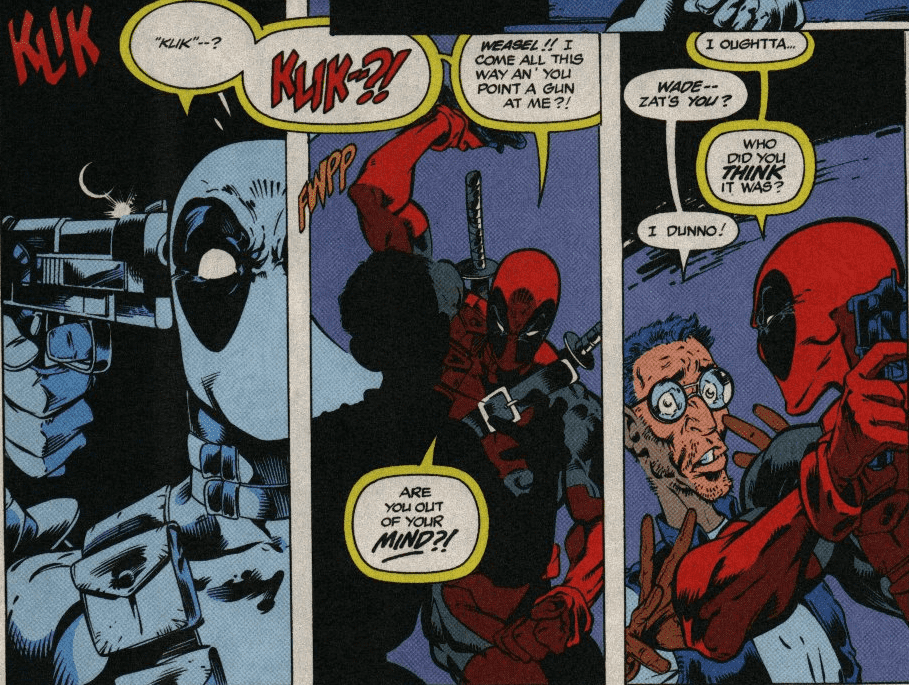

It’s Weasel, Deadpool’s informant/weapons supplier/ambiguous best friend. When Deadpool voices his displeasure at being ambushed, Weasel apologizes and makes this interesting remark: “You know I know nothing short of a nuke can take you out.”
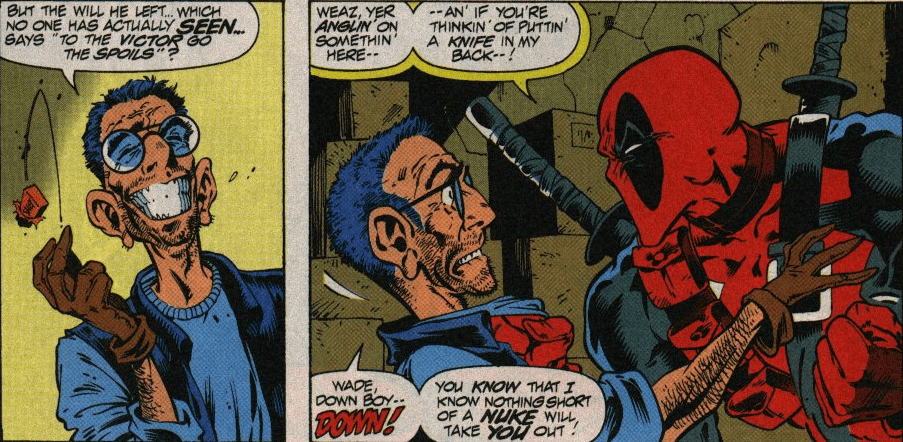

Notes of interest:
Though it might seem prosaic now, this is the first time we witness Deadpool in action against opponents that aren’t the main protagonists of their own comic book and writer Fabian Nicieza and artist Joe Madureira frame a fun display of Deadpool’s fighting style and vast array of weaponry. Deadpool used smoke bombs in his fight against Nomad in the previous entry and here he uses bolas (throwing weapons with weights on either end which ensnare opponents).
Not only is this the first time we hear mention of Deadpool’s healing factor, it’s also the first time we see Deadpool and Weasel work in tandem (although Weasel will retcon this and reveal in a future issue of Deadpool that it’s not the first time the two have met.) Weasel is played by T.J. Miller in the Deadpool film.
Differences in Deadpool:
The reaction to Deadpool’s cancer-scarred body is much more jarring to those who witness it in Deadpool: The Circle Chase than those who witness it in future mini-series and Deadpool’s own ongoing. Not only is his skin heavily scarred, but it’s riddled with tumors and he has clumps of sparse, blonde hair sprouting from his head.
By the time Deadpool Vol. 1, whose first issue is released in 1997, has rolled around Deadpool has started using a holographic projector to hide his disfigured appearance from others.
Favorite Quote:
“Come ta think of it — I’ve seen tougher Ken dolls than you! An’ I mean take yer pick here — mod-hair Ken — disco Ken — summer fun Ken — I let Barbie whip me ‘cos I’m a wuss Ken — Any o’ you guys lissenin’ t’me?”
Deadpool vs. Juggernaut and Black Tom
Juggernaut and Black Tom both make an appearance in the Deadpool 2 film (2018), but the first time he faced them in the comic books was in Deadpool: The Circle Chase #2 (September, 1993)
Notable differences:
Unlike in Deadpool 2, in The Circle Chase, Deadpool doesn’t have X-Men strongman Colossus as backup against Juggernaut, one of the strongest characters in the Marvel Universe and a character who can go toe-to-toe with the Incredible Hulk. Add Juggernaut’s best friend Black Tom to the mix, whose deadlier comic book version has the power to project energy blasts from his hands — and it would seem the odds are very stacked against Deadpool…
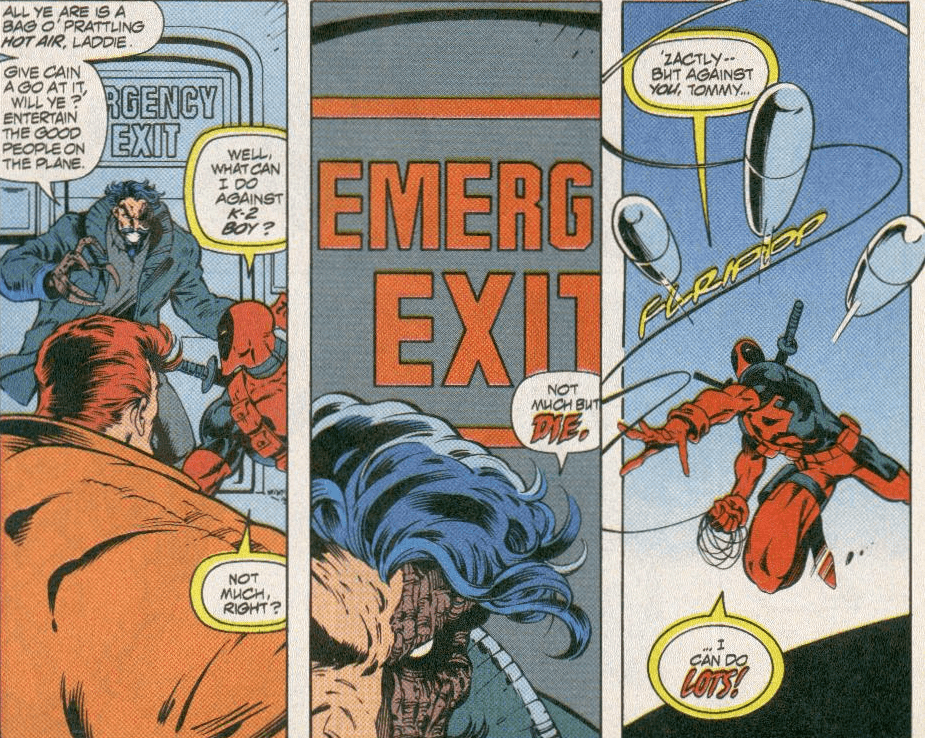

What happens?
Which is what makes Deadpool’s first encounter against Black Tom and the Juggernaut one of my favorite early Deadpool moments. Fabian Nicieza proves why Deadpool is a surprisingly resourceful and clever character in how he manages to narrowly defeat the villains in this encounter, a battle which hinges heavily upon the fact that it takes place on an airplane. (I feel bad for whichever TSA agent had to let Juggernaut through the security check.)
Favorite Quote: “Did he say Jughead-naut? Is that someone who searches for the Archies?”
Deadpool takes on a team of assassins hired to kill him (with the help of Banshee and Siryn)
Issue: Deadpool: Sins of the Past #1 | Writer: Mark Waid | Artist: Ian Churchill
Why this made the cut:
Deadpool takes on a team of highly skilled assassins, including a highly-skilled swordsman in one of his favorite bars, one he describes as “the only decent waterin’ hole east of the panhandle.”
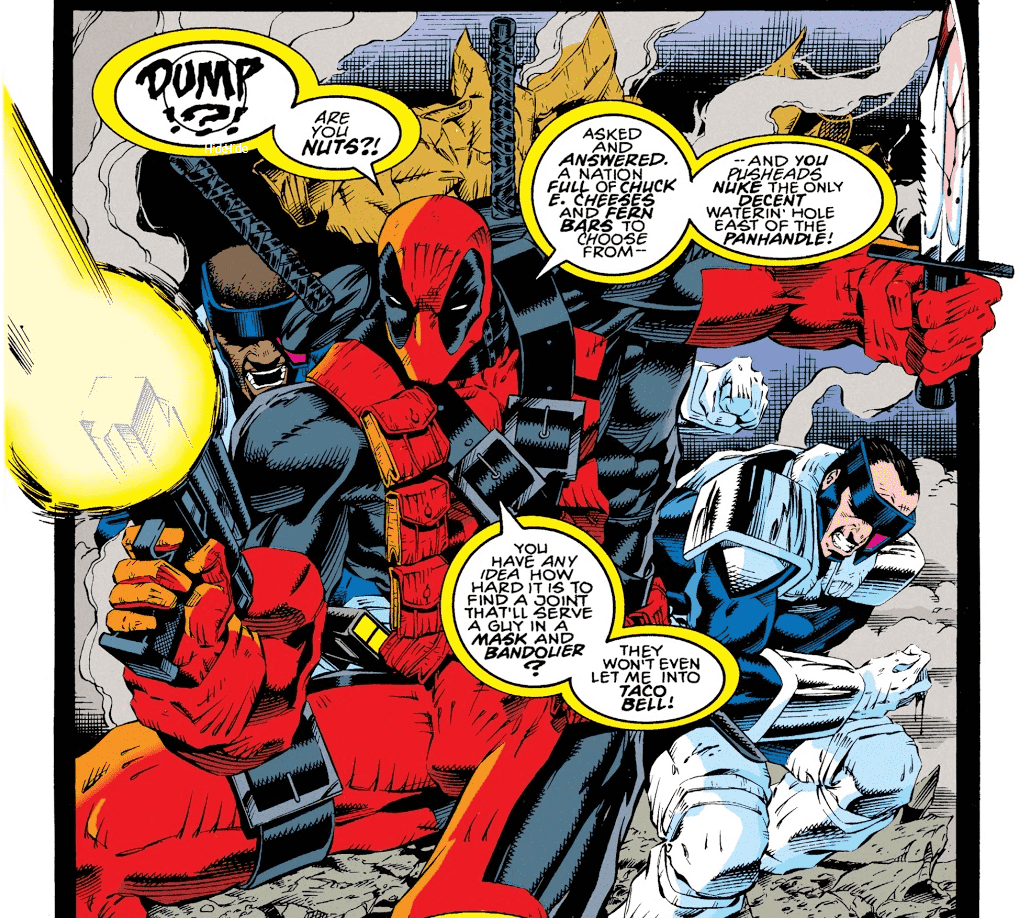

This issue is also the first encounter between Deadpool and his future love interest Siryn, daughter of former X-Men member Banshee, a mutant with the ability to emit powerful “sonic screams.” Writer Mark Waid set the groundwork for Deadpool and Siryn’s burgeoning relationship in this issue, one which extends into the early issues of Joe Kelly’s run in Deadpool’s first ongoing series in Deadpool Vol. 1 (1997).
Notes of interest: Deadpool and Banshee have worked together in the past, as his “You owe me somethin’, Irish. Remember the Farouk affair?” implies. As we learn in issue #2, it’s a big enough save that it tempers Banshee enough to let his daughter Siryn work with Deadpool to find out more about the hit placed on Deadpool’s head by Black Tom Cassidy.
The first-ever fight between Deadpool vs. Wolverine
Issue: Wolverine Vol. 2 #88 | Writer: Larry Hama | Artist: Adam Kubert, Fabio Laguna
Although this isn’t the first time fellow Canadians Deadpool and Wolverine meet within the Marvel Universe timeline, 1994’s Wolverine #88 is technically the first time we as comic book fans get to see Deadpool and Wolverine, both former candidates of the Weapon X program imbued with healing factors, throw down.
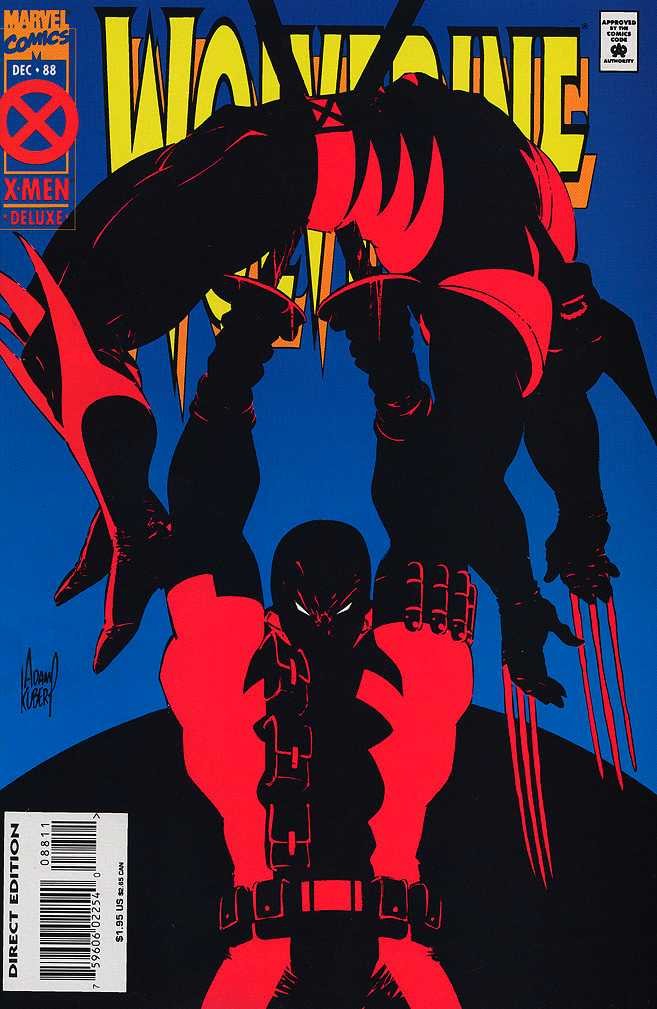

As you can judge from the cover, Deadpool gives Wolverine the fight of his life.
What happens?
Wolverine has been called to check on the new Weapon X, Garrison Kane, as a favor to a friend. When he shows up to Kane’s apartment, he finds the place trashed by Deadpool, who is upset over Kane linking up with his ex-girlfriend Vanessa. Wolverine and Deadpool sit down and have a civil conversation about their differences and forge an instant friendship through an exchange on the inhumane treatment of subjects who underwent experimentation at Weapon X.
Just kidding. They fight.
Notes of interest:
This fight takes place in the time period directly following the X-Men “Fatal Attractions” crossover, whose culmination saw Magneto forcibly removing the adamantium from Wolverine’s skeleton, grievously wounding him.
As a result, the fight which takes place in Wolverine #88 between Deadpool and Wolverine sees a Logan with a diminished version of his healing factor as well as bone claws instead of adamantium. Most writers already give Deadpool’s healing factor the edge against Wolverine’s, even when the latter’s is at full power, so you can see why this proves a big problem for Wolverine in this particular encounter. It’s because of this Deadpool is able to gain the upper hand with a well-timed sword thrust to Wolverine’s lungs.
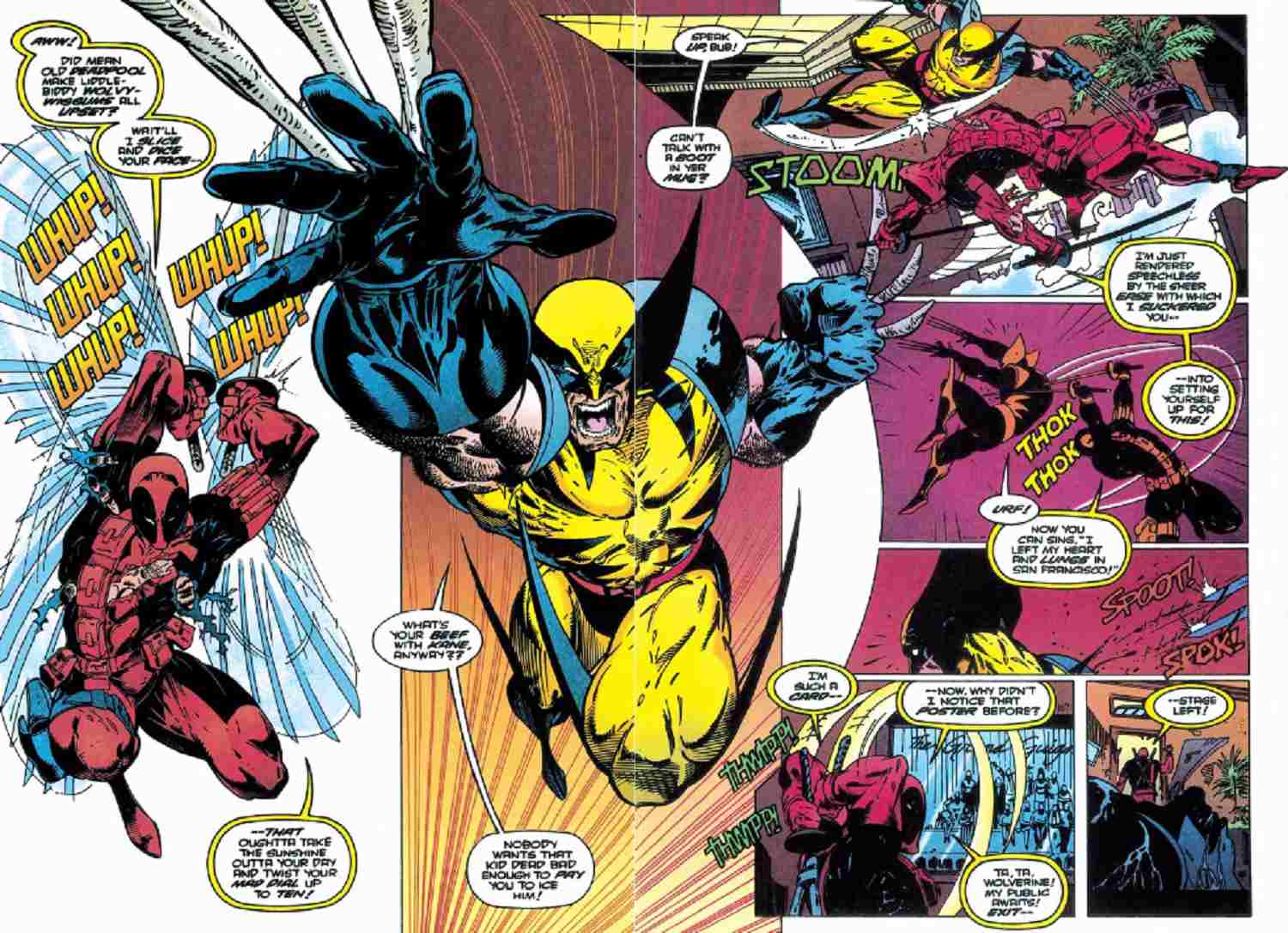

Favorite Quote: “Now you can sing, ‘I left my heart and lungs in San Francisco!'”
Which moment from Deadpool: Beginnings Omnibus was your favorite? Did we leave one of Deadpool’s best early moments from Deadpool: Beginnings Omnibus off this list? Let us know in the comments.





